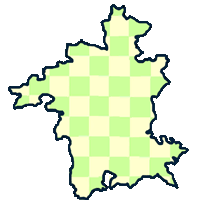One of Arkell's simul wins
White: Keith Arkell
Black: Andy Moore (Hagley Chess Club)
Worcester, May 2009
This game is one of 14 games in the simultaneous exhibition
|
1 |
d4 |
Nf6 |
| 2 |
Nf3 |
d5 |
| 3 |
c4 |
dxc4 |
| 4 |
Qa4+ |
Nc6 |
| 5 |
Nc3 |
e6 |
| 6 |
e3 |
|
| 6.Qxc4 Nb4 7.Qb3 c5 is another way for black to play (Illescas -Wolff, Biel 1993). |
| 6 |
... |
Bd6 |
| 7 |
Bxc4 |
0-0 |
| 8 |
0-0 |
Bd7 |
| An alternative is 8...e5 9.d5 Ne7 10.Qc2 with equality (Glotov-Flohr, Moscow, 1952). |
| 9 |
Qc2 |
Ne7? |
| The knight's retreat is too passive and better was the thematic advance of the e-pawn, a standard way for black to equalise in queen's pawn openings: 9...e5 10.d5 Nb4 11.Qb1= |
| 10 |
Qe2 |
|
| Objectively 10.e4 is better because it forces black back. Possibly Keith thought the postion might become blocked or white's advanced pawn centre might be attacked. 10...Ne8 11.e5 Bb4 12.Rd1 Bxc3 13.bxc3 White stands better. |
| 10 |
... |
Ned5? |
| Reinforcing the king side may be better: 10...Ng6 11.e4 e5 12.Rd1 with an edge for white. |
| 11 |
e4 |
Nxc3 |
| 12 |
bxc3 |
Be7 |
| 13 |
Bd3 |
h6? |
| Better and more adventurous is 13...c5!? 14.e5 Nd5 15.Qe4 g6 16.Bh6 Re8 White has a free hand on the king side and black will find it very difficult to defend. |
| 14 |
e5 |
Nd5 |
| 15 |
Qe4 |
f5 |
| 16 |
exf6
ep |
Nxf6 |
|
|
17 |
Qh4 |
|
| Grabbing the b-pawn achieves a clear plus and material advantage: 17.Qxb7!? Nd5 18.Bd2, but the English Champion aims for a king side breakthrough. |
| 17 |
... |
Bc6 |
| 18 |
Ne5 |
Bd7? |
| 18...Nd7 19.Qg3 Nxe5 20.dxe5 g5 leaves the black king exposed but was better. |

Position after18...Bd7?
|
| 19 |
Bxh6! |
Ne8 |
| 19...gxh6 Also loses, but not so quickly: 20.Qg3+ Kh8 21.Ng6+ Kg7 22.Nxe7+ Kf7 23.Ng6 Rg8 24.Ne5+ Ke7 when white is two pawns up with black's king caught in the centre. |
| 20 |
Bh7+!! |
Kh8 |
| 20...Kxh7 allows white to clear out black's king side pieces. 21.Bg5+ Kg8 22.Bxe7 Qc8 23.Ng6 Kf7 24.Nxf8 |
| 21 |
Bg5!! |
g6 |
| 21...Bxg5 22.Ng6# |
| 22 |
Bxg6+ |
Kg8 |
| 23 |
Qh7# |
1-0 |
|
|

